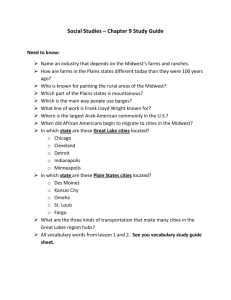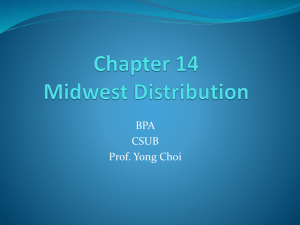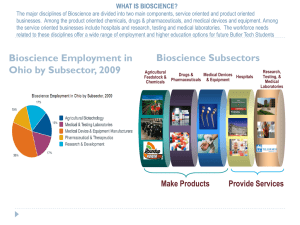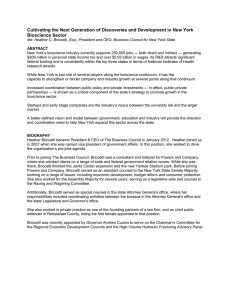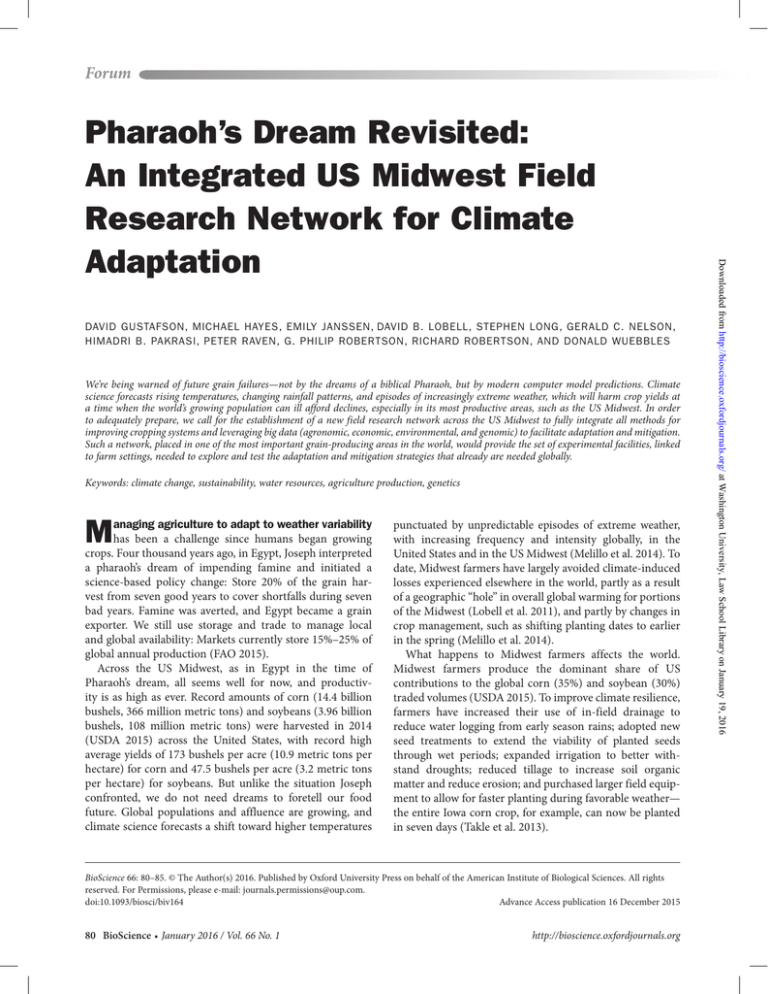
Pharaoh’s Dream Revisited:
An Integrated US Midwest Field
Research Network for Climate
Adaptation
DAVID GUSTAFSON, MICHAEL HAYES, EMILY JANSSEN, DAVID B. LOBELL, STEPHEN LONG, GERALD C. NELSON,
HIMADRI B. PAKRASI, PETER RAVEN, G. PHILIP ROBERTSON, RICHARD ROBERTSON, AND DONALD WUEBBLES
We’re being warned of future grain failures—not by the dreams of a biblical Pharaoh, but by modern computer model predictions. Climate
science forecasts rising temperatures, changing rainfall patterns, and episodes of increasingly extreme weather, which will harm crop yields at
a time when the world’s growing population can ill afford declines, especially in its most productive areas, such as the US Midwest. In order
to adequately prepare, we call for the establishment of a new field research network across the US Midwest to fully integrate all methods for
improving cropping systems and leveraging big data (agronomic, economic, environmental, and genomic) to facilitate adaptation and mitigation.
Such a network, placed in one of the most important grain-producing areas in the world, would provide the set of experimental facilities, linked
to farm settings, needed to explore and test the adaptation and mitigation strategies that already are needed globally.
Keywords: climate change, sustainability, water resources, agriculture production, genetics
M
anaging agriculture to adapt to weather variability has been a challenge since humans began growing
crops. Four thousand years ago, in Egypt, Joseph interpreted
a pharaoh’s dream of impending famine and initiated a
science-based policy change: Store 20% of the grain harvest from seven good years to cover shortfalls during seven
bad years. Famine was averted, and Egypt became a grain
exporter. We still use storage and trade to manage local
and global availability: Markets currently store 15%–25% of
global annual production (FAO 2015).
Across the US Midwest, as in Egypt in the time of
Pharaoh’s dream, all seems well for now, and productivity is as high as ever. Record amounts of corn (14.4 billion
bushels, 366 million metric tons) and soybeans (3.96 billion
bushels, 108 million metric tons) were harvested in 2014
(USDA 2015) across the United States, with record high
average yields of 173 bushels per acre (10.9 metric tons per
hectare) for corn and 47.5 bushels per acre (3.2 metric tons
per hectare) for soybeans. But unlike the situation Joseph
confronted, we do not need dreams to foretell our food
future. Global populations and affluence are growing, and
climate science forecasts a shift toward higher temperatures
punctuated by unpredictable episodes of extreme weather,
with increasing frequency and intensity globally, in the
United States and in the US Midwest (Melillo et al. 2014). To
date, Midwest farmers have largely avoided climate-induced
losses experienced elsewhere in the world, partly as a result
of a geographic “hole” in overall global warming for portions
of the Midwest (Lobell et al. 2011), and partly by changes in
crop management, such as shifting planting dates to earlier
in the spring (Melillo et al. 2014).
What happens to Midwest farmers affects the world.
Midwest farmers produce the dominant share of US
contributions to the global corn (35%) and soybean (30%)
traded volumes (USDA 2015). To improve climate resilience,
farmers have increased their use of in-field drainage to
reduce water logging from early season rains; adopted new
seed treatments to extend the viability of planted seeds
through wet periods; expanded irrigation to better withstand droughts; reduced tillage to increase soil organic
matter and reduce erosion; and purchased larger field equipment to allow for faster planting during favorable weather—
the entire Iowa corn crop, for example, can now be planted
in seven days (Takle et al. 2013).
BioScience 66: 80–85. © The Author(s) 2016. Published by Oxford University Press on behalf of the American Institute of Biological Sciences. All rights
reserved. For Permissions, please e-mail: journals.permissions@oup.com.
doi:10.1093/biosci/biv164
Advance Access publication 16 December 2015
80 BioScience • January 2016 / Vol. 66 No. 1
http://bioscience.oxfordjournals.org
Downloaded from http://bioscience.oxfordjournals.org/ at Washington University, Law School Library on January 19, 2016
Q1
Forum
Forum
However, such adaptations are unlikely to be sufficient in
the future. Temperatures will continue to rise, precipitation
patterns will become more variable, more extreme weather
will occur, and pests and pathogens are on the move (Melillo
et al. 2014). By midcentury, temperatures in Illinois will
likely be closer to those of today’s mid-South, and precipitation will range somewhere between that of today’s East Texas
and that of the Carolinas (figure 1). Vapor-pressure deficits,
a measure of the atmosphere’s drying power, are responsible
for significant yield losses in corn (Lobell et al. 2014) and
will also increase, potentially constraining future rates of
yield gain (Ort and Long 2014).
This is all challenging news for Midwest farmers: As we
show in figure 1, current corn varieties could see yield reductions of more than 25% with the climate predicted for 2050
(Takle et al. 2013). Nor will warmer temperatures farther
north offset lost Midwest yields: Poor soils, low rainfall, or
both will constrain productivity in those regions (Rosegrant
2012). Qualitatively, then, these threats have the potential to
reduce global food security. But by how much? Recent predictions of global food price increases due to climate change
through 2050 range from negligible to more than 60%
(Nelson et al. 2014), reflecting a host of climate- and foodproduction-modeling uncertainties that must be addressed.
http://bioscience.oxfordjournals.org
These challenges have led to calls for aggressive increases
in agricultural research spending, thus far largely unheeded.
Kennedy (2014), for example, recently asked in Science,
“If we want to combat new strains of pests that destroy
crops, find new crop varieties enriched in nutritional value,
improve yields, develop resistance to disease and drought,
and provide environmentally sensitive cultivation practices,
then agricultural research must be a priority. Why isn’t it?”
(p. 13).
We believe that this need is particularly acute for the
Midwest. Intensifying climate change in the face of a growing global demand for more nutritious and more sustainably
produced food, together with the increasing prevalence
of biotic stressors (weed, insect, and microbial pests), all
combine to compel the United States to take a vastly more
proactive approach to help Midwest farmers successfully
adapt to a very challenging future. Furthermore, because the
Midwest has extensive infrastructure and is a major source
for crops grown around the world, it is an ideal setting to
explore and test climate mitigation and adaptation strategies
that could be implemented globally. Finally, the design and
implementation of the network itself could serve as a model
for the establishment of similar systems in other world
regions.
January 2016 / Vol. 66 No. 1 • BioScience 81
Downloaded from http://bioscience.oxfordjournals.org/ at Washington University, Law School Library on January 19, 2016
Figure 1. The US map shows projections for where Illinois weather will have “moved” by the 2035–2065 period, relative to
1971–2000, based on changes in warm-season (May through September) average daily temperature and precipitation from
four Coupled Model Intercomparison Project Phase 5 (CMIP5) climate models run using the Representative Concentration
Pathways (RCP) 8.5 (high emissions) scenario (IPCC 2013). The bar chart shows the corresponding potential climate
change effects on average Illinois corn yields using the Decision-Support System for Agrotechnology Transfer (DSSAT)
CERES model (Jones et al. 2003), holding all parameters at current values except for climate.
Forum
82 BioScience • January 2016 / Vol. 66 No. 1
also ensure that the research carried out across this network
will be of immediate relevance and practical applicability to
farmers.
Understanding farmer response to climate change is a
key element of the proposal. Social-science research would
be integrated into this network at the outset to capture the
existing interactions between biology and human behavior
and provide guidance on the direction of future research.
Studies of climate adaptation suggest that science and technology are most useful when they are fully integrated into
social, economic, and political systems that are capable and
ready to integrate them (Melillo et al. 2014).
An integrated network is needed because existing empirical data provide only a very limited basis for understanding
the impacts of future weather, CO2, O3, and biotic stressors
on crop production, nutritional makeup, socioeconomic
factors (e.g., farm incomes, prices, and land values), and
sustainability outcomes (e.g., greenhouse gas emissions,
soil degradation, and water quality). Recent field studies in
which some of the biological factors have been experimentally manipulated (Leakey et al. 2012) have demonstrated
our inability to extrapolate growth-chamber and greenhouse
results to field situations. For example, whereas crop models
based on in vitro experiments universally predict a positive
response to increasing CO2, in situ experiments show these
predictions are either overly optimistic or unfounded—compromising predictions of future cropping-system performance. Systematic and integrated field studies are needed
in strategic locations across a range of soil and climatic
conditions. Our vision is for a network of such sites, fully
integrated with research teams focused on each of several
adaptation and mitigation approaches, as we describe briefly
below.
Our vision emphasizes the integration of interdisciplinary research to bolster a systems-level understanding, which is crucial but currently far from realized (NSF
2015). Existing field research networks, such as the Long
Term Agricultural Research Network (LTAR), the Soil
Climate Analysis Network (SCAN), and the Greenhouse
Gas Reduction through Agricultural Carbon Enhancement
Network (GRACEnet), tend to be focused on relatively narrow climate-related topics. We propose that only an integrated interdisciplinary program can address these broad
enterprise-level challenges by having the direct, coordinated engagement of researchers and other individuals with
highly diverse but relevant expertise, including agribusiness,
agronomists, bioinformaticists, biologists, climatologists,
economists, environmental scientists, farmer–producers,
hydrologists, information technologists, modelers, plant
breeders, and policy experts. Engineering has long recognized the necessity of designing industrial processes from a
systems perspective: the need to anticipate how a change in
one component can create unwelcome surprises elsewhere,
affecting input costs, expenses, and outcomes that can affect
the entire system. Applying this approach in agriculture
has thus far failed because of lack of integration. Cropping
http://bioscience.oxfordjournals.org
Downloaded from http://bioscience.oxfordjournals.org/ at Washington University, Law School Library on January 19, 2016
An integrated field research network
We call for the establishment of a new network of field
research sites where precise data on the performance of current and future crops and cropping systems and farm level
management practices in the US Midwest could be gathered.
For efficiency and continuity with current research activities, we propose that the existing public agriculture research
infrastructure within this region could form the core of
the new network, which would include both public- and
private-sector collaborators. The USDA Midwest Climate
Hub would be another important public-sector partner, as
would the many land-grant universities and their associated
extension systems across the region. Private-sector partners
would include farmers, as well as the companies that provide
agronomic inputs and services and purchase farm outputs.
Such a network, placed in one of the most important
grain-producing areas in the world, would provide the set
of experimental facilities needed to explore and test the
adaptation and mitigation strategies that already are needed
globally for similar agroecosystems. Given current cropping patterns and investments, the initial focus should be
on major current grains—corn, soybean, and wheat—with
effort also directed toward crops novel to the region that
might become more important under altered climates. It
should also experiment with crops that are currently minor
in the area but that could become important in future climate and market environments. To be clear, a significant
adjustment of specific US Midwest corn and soybean strategies would be required before they could be applied to other
regions and crops, but the integrative approach proposed
here, including systematic data collection and management,
should have broad applicability in other regions. Individual
sites might include experiments such as the SoyFACE field
study, established in central Illinois and elsewhere in the
early part of this century (Ort et al. 2006), which enabled in
situ alterations of various atmospheric constituents (e.g., carbon dioxide, CO2; ozone, O3). Sites would also include the
capability to evaluate cropping-system and farmer responses
to altered temperature and precipitation and would provide
the knowledge to support a suite of potential adaptation
and mitigation approaches involving crop improvement,
emergent pest and disease threats, sustainable agricultural
practices, and innovative IT strategies (Arbuckle et al. 2013,
Haigh et al. 2015). The network would be designed to
include farmer-managed fields that capture on-farm decisionmaking and farm-level experiments with potential new
technologies.
One of the unique aspects of this network might be its
operation through a new public–private partnership involving the direct participation of individual grower–producers,
similar to another recently launched initiative focused on
soil health (Soil Health Partnership 2015). An advantage
to this strategy is the previously reported finding that most
farmers support actions to protect farmland (Arbuckle et al.
2013), suggesting that this is as an effective way to achieve
both adaptation to and mitigation of climate change. It will
Forum
to novel pests and diseases that invade newly vulnerable
regions, including the movement of tropical and subtropical
pests into the Midwest. Monitoring alone is only the first
step to stemming new threats. Innovative and sustainable
methods of crop protection require identifying new sources
of disease resistance and modifying strategies for integrated
pest management (IPM) across a distributed network to
ensure that crop yields and quality are maintained without
sacrificing the biodiversity services provided by noncrop
plants, beneficial insects, and other taxa. Integrating pest
and pathogen dynamics into landscape and cropping system
models (Rosenzweig et al. 2013) will be especially important.
Improving crops. Genetic variation is the basis for improved
crops and is achieved by traditional breeding and advanced
breeding technologies, including genetic engineering.
However, not enough is known about natural variation; how
variation is expressed in response to high temperature, O3,
CO2, pests, and disease; and how all of these factors might
influence the yields and nutritional content of the harvested
crop. That crops fall short of the theoretically attainable yield
because of increased CO2 (Leakey et al. 2012) makes this
knowledge gap especially noteworthy as ambient CO2 levels
continue to rise. Modern breeding methods make rapid
adaptation to new climates possible and should be used to
improve crop performance as the climate changes.
In parallel, molecular tools should be exploited to better
understand the mechanisms of response in these crops to
changes in environment. Genomewide association study
(GWAS), advanced imaging, and transcriptomics may be
especially important for understanding heat-wave effects on
ovule fertilization and possibly photosynthesis, the failure or
partial failure to respond positively to rising CO2, and the
mechanisms of damage and resistance to O3. Understanding
the gene networks underlying these responses will greatly
speed the development and selection of variants that thrive
under adaptive conditions. At the same time, synthetic-biology approaches should be explored, with RNAi or manipulations to up- or down-regulate genes.
Another particularly promising area of biological research
is on the so-called “plant–soil microbiome”: understanding
the many crucial roles played by the hundreds of billions
of microbes that live in soil and within plants themselves
(Smith 2014). Multiple distinct microbial communities live
within the various regions of this biome, possessing a genetic
diversity that dwarfs their plant hosts. Biologists are just
beginning to comprehend the capacity for these microbes to
provide plants access to nutrients and help suppress disease.
Microorganisms may provide the means for combating plant
disease faster than breeding and genetic modification do,
and they could also help improve the efficiency of fertilizer
use. Each of these areas of research has direct relevance to
either climate adaptation or mitigation—or both.
Improving sustainable agricultural practices. Agricultural activi-
Adapting to emerging pest and disease threats. A changing climate means increased vulnerability to existing threats and
http://bioscience.oxfordjournals.org
ties themselves contribute to global greenhouse gas emissions and other environmental harms, including impacts on
soil health, surface- and groundwater quality, biodiversity,
and groundwater supply. As Midwest farmers continue to
increase production in response to global food demand,
environmental sustainability must be improved. New practices based on emerging technologies and an improved
understanding of ecosystem service trade-offs (Robertson
et al. 2014) offer much promise. Winter cover crops, precision agriculture, improved decision-support systems, conservation tillage, improved knowledge of favorable and
unfavorable soil and plant microbiomes, advanced fertilizer
formulations, real-time crop sensing, variable rate planting,
fertilizing, and spraying technologies are but a few of the
tools now or soon to be available. Although some of these
are already widely practiced (e.g., conservation tillage),
faster adoption of the newer ideas would be accelerated
by providing more information to farmers and integrating
new big-data generators such as drone-based sensors. And
regular surveys of farm practices in response to changing
biological and socioeconomic conditions would inform
the potential priorities of research activities. By including
experiments replicated across the new research network
with comprehensive data collection, clearer guidance can be
given on the sustainability outcomes associated with such
practices. A key part of this effort must be to evaluate the
short- and long-term economic benefits to famers of the
range of potential practices.
Deploying innovative IT capabilities. Unless a modern-day Joseph
appears, computer models are the only tool that can provide
plausible forecasts of future climate, crop, and economic
responses. However, the models must be improved, and the
key to crop- and economic-model improvement is better
data. There is a growing range of efforts to make existing public- and private-sector data open and more widely
available. This includes the president’s new Climate Data
Initiative (White House Press Office 2014), as well as commitments by the private sector to release crop-breeding
trial data through open data portals (Gustafson et al. 2014).
But new data-collection efforts are also essential, and we
believe it is essential that all data generated through the new
January 2016 / Vol. 66 No. 1 • BioScience 83
Downloaded from http://bioscience.oxfordjournals.org/ at Washington University, Law School Library on January 19, 2016
systems are rarely researched from genome to landscape by
multidisciplinary teams working in concert (Robertson et al.
2004). Therefore, we’ve failed to discover many of the tradeoffs and synergies (socioeconomic and environmental) that
result from poorly explored or unknown interconnections.
Achieving an integrated interdisciplinary understanding of
crops and cropping systems and making accurate predictions of the impacts of climate change demand a network
of sites at which such experiments can be deployed. We
describe below four areas in which integration—both within
and among—is crucial for the design of ever more productive and climate-resilient cropping systems.
Forum
Next steps
The initiative described here will require a major investment in financial resources, human capital, and institutional
innovation. In order to be cost effective, we propose that
these investments come in a coordinated manner from a
combination of public- and private-sector sources. The 2014
Farm Bill created an instrument to fund just such endeavors: The Foundation for Food and Agricultural Research
(FFAR), announced by USDA Secretary Tom Vilsack in June
2014, will “leverage public and private resources to increase
the scientific and technological research, innovation, and
partnerships critical to boosting America’s agricultural economy.” The integrated field research network we envisage here
would be an ideal project to begin realizing the FFAR vision.
It would also become a significant global resource for developing and testing the integrated adaptation strategies that
will be needed to help all of the world’s farmers confront the
challenges of increasing climate change.
As was detailed in both the Third US National Climate
Assessment (Melillo et al. 2014) and in the more recent
report on food-system resilience to extreme weather
(UK Global Food Security Programme 2015), dramatic
changes (both socioeconomic and climatic) are coming at
local, national, and global scales that are likely to profoundly
affect farmers in the US Midwest and beyond. The network
we propose will provide a tremendous boost to the quantity
and quality of information needed to inform the policy and
investment decisions that must be made in the face of a
rapidly changing climate—in order to avoid the more dire
outcomes that await if we fail to plan appropriately. Merely
expanding existing research networks and doing things the
way we’ve always done them will be insufficient. Only by
having an integrated interdisciplinary network in place will
we be able to address with agility the complex interactions
between climate s­ cience, biology, information technology,
and human behavior that will inform both better decisions
and more beneficial ultimate outcomes.
84 BioScience • January 2016 / Vol. 66 No. 1
Funding statement
Funding for this work was provided by Washington
University in St. Louis through the Workshop on Climate
Change and Agriculture in the Midwest held September 4-5,
2014 in St. Louis, Missouri.
References cited
Arbuckle JG, Prokopy LS, Haigh T, Hobbs J, Knoot T. 2013. Climate
change beliefs, concerns, attitudes toward adaptation and mitigation
among farmers in the Midwestern United States. Climatic Change 117:
943–950.
[FAO] Food and Agricultural Organization of the United Nations. 2015.
FAO Food Price Index. (3 May 2015; www.fao.org/worldfoodsituation/
foodpricesindex/en)
Gustafson DI, et al. 2014. Climate adaptation imperatives: Untapped
global maize yield opportunities. International Journal of Agricultural
Sustainability 12: 471–486. doi:10.1080/14735903.2013.867694
Haigh T, Takle E, Andresen J, Widhalm M, Carlton JS. 2015. Mapping
the decision points and climate information use of agricultural
producers across the US Corn Belt. Climate Risk Management 7:
20–30.
[IPCC] Intergovernmental Panel on Climate Change. 2013. Climate Change
2013: The Physical Science Basis. Contribution of Working Group I to
the Fifth Assessment Report of the Intergovernmental Panel on Climate
Change. Cambridge University Press.
Jones JW, Hoogenboom G, Porter C, Boote K, Batchelor W, Hunt L, Ritchie
J. 2003. The DSSAT cropping system model. European Journal of
Agronomy 18: 235–265.
Kennedy D. 2014. Building agricultural research. Science 346: 13.
Leakey A, Bishop KA, Ainsworth EA. 2012. A multi-biome gap in understanding of crop and ecosystem responses to elevated CO2. Current
Opinion in Plant Biology 15: 228–236.
Lobell DB, Schlenker W, Costa-Roberts J. 2011. Climate trends and global
crop production since 1980. Science 333: 616–620.
Lobell DB, Roberts MJ, Schlenker W, Braun N, Little BB, Rejesus RM,
Hammer GL. 2014. Greater sensitivity to drought accompanies maize
yield increase in the US Midwest. Science 344: 516–519.
Melillo JM, Richmond TC, Yohe GW, eds. 2014. Climate Change Impacts in
the United States: The Third National Climate Assessment. US Global
Change Research Program. doi:10.7930/J0Z31WJ2
Nelson GC, et al. 2014. Climate change effects on agriculture: Economic
responses to biophysical shocks. Proceedings of the National Academy
of Sciences 111: 3274–3279.
[NSF] National Science Foundation. 2015. NSF FY 2016 Budget Request
to Congress. NSF. (3 May 2015; www.nsf.gov/about/budget/fy2016/
pdf/01_fy2016.pdf )
Ort DR, et al. 2006. SoyFACE: The effects and interactions of elevated CO2
and O3 on soybean. Pages 71–86 in Nosberger J, et al., eds. Managed
Ecosystems and CO2: Case Studies, Processes, and Perspectives. Springer.
Ort DR, Long SP. 2014. Limits on yields in the Corn Belt. Science 344:
484–485.
Robertson GP, Broome JC, Chornesky EA, Frankenberger JR, Johnson P,
Lipson M, Miranowski JA, Owens ED, Pimentel D, Thrupp LA. 2004.
Rethinking the vision for environmental research in US agriculture.
BioScience 54: 61–65.
Robertson GP, Gross KL, Hamilton SK, Landis DA, Schmidt TM,
Snapp SS, Swinton SM. 2014. Farming for ecosystem services:
An ecological approach to production agriculture. BioScience 64:
404–415.
Rosegrant MW. 2012. International Model for Policy Analysis of Agricultural
Commodities and Trade (IMPACT) Model Description. International
Food Policy Research Institute.
Rosenzweig C, et al. 2013. The Agricultural Model Intercomparison and
Improvement Project (AgMIP): Protocols and pilot studies. Agricultural
and Forest Meteorology 170: 166–182.
http://bioscience.oxfordjournals.org
Downloaded from http://bioscience.oxfordjournals.org/ at Washington University, Law School Library on January 19, 2016
network be publicly available in order to accelerate the pace
of innovation.
An integrated network will allow field researchers to team
directly with those involved in data science, simulation
modeling, and other modern IT capabilities (e.g., sensors,
precision agriculture, smart-phone apps, and citizen-science
efforts) to explore innovative adaptive strategies. The recent
explosion of private-sector investment in applications of
data science to Midwest cropping operations (as was typified
by the purchase of The Climate Corporation by Monsanto)
suggests that the pace of future advancements will be rapid.
It will be important for the public sector to engage in appropriate policy responses to ensure maximum public good is
realized as these developments unfold. The field research
network we are proposing would make this possible and
would also help to provide the fundamental knowledge on
which proprietary advances are based.
Forum
http://bioscience.oxfordjournals.org
President’s Climate Data Initiative. Office of the Press Secretary.
(3 May 2015; www.whitehouse.gov/the-press-office/2014/07/29/factsheet-empowering-america-s-agricultural-sector-and-strengthening-fo)
David Gustafson is affiliated with the Center for Integrated Modeling of
Sustainable Agriculture and Nutrition Security, ILSI Research Foundation,
in Washington, DC. Michael Hayes is with the National Drought Mitigation
Center at the University of Nebraska, in Lincoln. Emily Janssen, Stephen Long,
Gerald Nelson, and Donald Wuebbles are affiliated with the University of
Illinois, in Urbana-Champaign. David B. Lobell is with the Center on Food
Security and the Environment at Stanford University, in Stanford, California.
Himadri B. Pakrasi is with the International Center for Advanced Renewable
Energy and Sustainability at Washington University, in St. Louis, Missouri.
Peter Raven is affiliated with the Missouri Botanical Garden, in St. Louis.
G. Philip Robertson is with the WK Kellogg Biological Station at Michigan
State University, in Hickory Corners. Richard Robertson is affiliated with the
International Food Policy Research Institute, in Washington, DC.
January 2016 / Vol. 66 No. 1 • BioScience 85
Downloaded from http://bioscience.oxfordjournals.org/ at Washington University, Law School Library on January 19, 2016
Soil Health Partnership. 2015. Soil Health Partnership: A Project to Make
Agriculture More Productive and Sustainable through Improved Soil
Health. National Corn Growers Association. (2 September 2015; http://
soilhealthpartnership.org)
Smith PA. 2014. Untapped plant microbiome could help feed billions.
Scientific American. (6 November 2015; www.scientificamerican.com/
article/untapped-plant-microbiome-could-help-feed-billions)
Takle ES, Gustafson DI, Beachy R, Nelson GC, Mason-D’Croz D, Palazzo
A. 2013. US food security and climate change: Agricultural futures.
Economics (art. 2013-34). doi:10.5018/economics-ejournal.ja.2013-34.
UK Global Food Security Programme. 2015. Extreme Weather and
Resilience of the Global Food System. UK–US Taskforce on Extreme
Weather and Global Food System Resilience.
[USDA] US Department of Agriculture. 2015. World Agricultural Supply
and Demand Estimates Report (WASDE. USDA Office of the Chief
Economist. (3 May 2015; www.usda.gov/oce/commodity/wasde)
White House Press Office. 2014. Fact Sheet: Empowering America’s
Agricultural Sector and Strengthening Food Resilience through the

